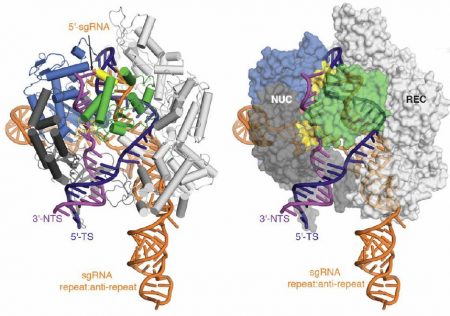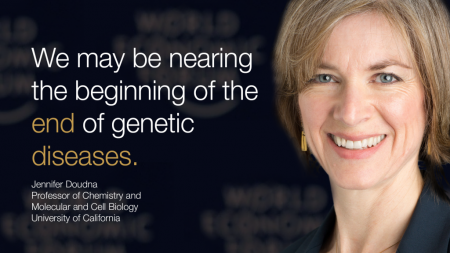August 31, 2017 – A backhoe on a nearby street has kept me from posting new content to 21st Century Tech blog for the last two days. My Internet Service Provider was kind enough to send me a thunderstick, a wireless connection device that served to let me do some work last evening, largely cleaning out and responding to emails. But now I’m back online with access to the cloud and my blog site.
I used the 48-hour hiatus to finish reading “A Crack in Creation: Gene Editing and the Unthinkable Power to Control Evolution.” Written by Jennifer Doudna with co-author Samuel Sternberg, this is a book about unlocking the secrets of DNA using a new technology, one that I have written about before called CRISPR/Cas9.
CRISPR gives humans the power to edit DNA, and by edit I mean the capability to cure diseases, enhance biology, address world hunger, and alter humanity either for the good or for evil.
Doudna is on the faculty of UC Berkeley. Her laboratory focuses on molecular and cell biology and it is her work that has created what she calls the crack in creation, CRISPR/Cas9. And exactly what is this crack? CRISPR/Cas9 is a technology derived from a natural process within a bacteria that combines RNA and the Cas9 protein into a DNA editor capable of slicing out bad genes and replacing them with healthy ones.
CRISPR/Cas9 first appeared on the scene in 2012 when Doudna published the research in an article entitled, “A Programmable Dual-RNA-Guided DNA Endonuclease in Adaptive Bacterial Immunity” in the journal Science. She had learned about CRISPR from an associate at a conference and began investigating it only to discover that when combined with a particular protein, Cas9 it could do amazing things.
When introduced into a cell with damaged genetic information, CRISPR/Cas9 could excise the bad DNA code and replace it with a correct genetic sequence. And CRISPR/Cas9 could do this in cells with multiple defects, snipping and replacing, and snipping and replacing again. Nothing like this had ever been seen before.

For Doudna and her laboratory colleagues, it was a revelation that led them to publish and share their discovery with the world. Soon laboratories all over the planet were slicing and dicing with CRISPR/Cas9. That’s when she suddenly asked herself, had she created a monster?
Doudna didn’t start out trying to create a tool to reinvent biology. She wanted to understand CRISPRs, these clustered regularly interspaced short palindromic repeats of RNA sequences found in the genetic material within bacteria. CRISPRs turned out to be bacteria’s way of fighting viral infections. CRISPRs within the cell grabbed invading viral RNA and signaled a specialized protein called Cas9 to come and deal with it. And the Cas9 protein turned out to be a great executioner, dicing up and destroying the viral RNA.
Doudna and her colleagues realized that there could be another use for this CRISPR/Cas9 partnership. It could be repurposed to cut out bad sequences of DNA and replace them with healthy ones. Strings of 20 base pairs within the DNA strand could be excised and replaced with a precision never seen before. That made CRISPR/Cas9 the ultimate tool for potentially correcting congenital diseases, for stopping pandemics, for creating crops capable of dealing with the worst conditions climate change could throw at us, and for much more. Simply manipulating short strings of individual base pairs within the DNA of every living thing was now possible.
But what could do good could also do evil. Could CRISPR/Cas9 be a malevolent force unleashed upon the world? In her book, “A Crack in Creation,” Doudna describes a recurring nightmare.
She is approached by a colleague who asks her to teach a person about how the technology works. She writes, “I followed my colleague into a room to meet this person and was shocked to see Adolf Hitler, in the flesh, seated in front of me.” And Hitler speaks saying “I want to understand the uses and implications of this amazing technology you’ve developed.” Doudna talks about being jolted from sleep with her heart racing. She recognized that in CRISPR/Cas9 her team had created a tool of “incredible power, one that could be devastating if it fell into the wrong hands.”
Doudna suddenly thought back to the birth of the atom bomb, then the hydrogen bomb, and finally the Cold War. The second and third were unintended consequences of technological discovery.
Oppenheimer, the father of the atom bomb has been quoted about this period of discovery. In considering the birth of the bomb he states, “It is my judgment in these things that when you see something that is technically sweet, you go ahead and do it and you argue about what to do about it only after you have had your technical success.” Did Oppenheimer envision the Cold War in building the bomb? No.Doudna was now asking herself about unintended consequences of discovering CRISPR/Cas9 and its awesome power.
But Doudna was now asking herself about the unintended consequences of her discovery of CRISPR/Cas9 and the potential implications of its awesome power.
There is no doubt that CRISPR/Cas9 represents a biomedical revolution. Nothing in medicine, and biology will ever be the same. Of course, the public may raise pitchforks in fear of the potential chimeras and Frankenstein monsters CRISPR/Cas9 could produce if used with malicious intent. But should those fears dictate the pace at which research proceeds using the technology?of Science fiction about humans toying with nature is replete with warnings of our potential overreach. In particular, it is using CRISPR/Cas9 on what is called our
Humans toying with nature is a common science fiction theme replete with warnings of potential overreach. What is that overreach? With CRISPR/Cas9 it would be the manipulation of the germline, our sperm, eggs, and embryos. Could we spawn a new eugenics arms race with different countries spurring their scientists to develop enhanced warriors?
So far laboratories experimenting with CRISPR/Cas9 have been looking at the diseases that appear in somatic cells and seeing if the technology can defeat diseases like muscular dystrophy, cystic fibrosis, sickle cell anemia, and various cancers. Others that are using germ cells have experimented with nonviable embryos. In the case of the latter recent published results show that CRISPR/Cas9 can correct genetic sequences responsible for causing hypertrophic cardiomyopathy, a congenital heart condition. And although the embryos used in the latter study were nonviable, they could have been.
Doudna and her fellow scientists, researchers, philosophers, and ethicists continue to wrestle with the positioning of the line in the sand that cannot be crossed related to CRISPR/Cas9 use. But no one wants to stop experimenting with a technology so revolutionary it will change how medicine is practiced as this decade comes to an end and beyond.









